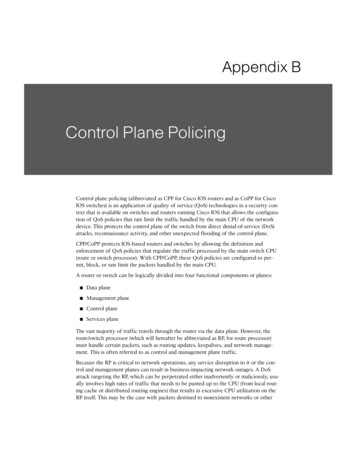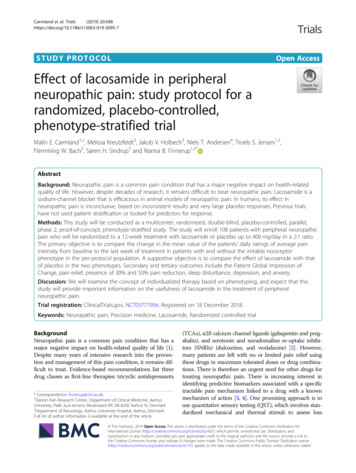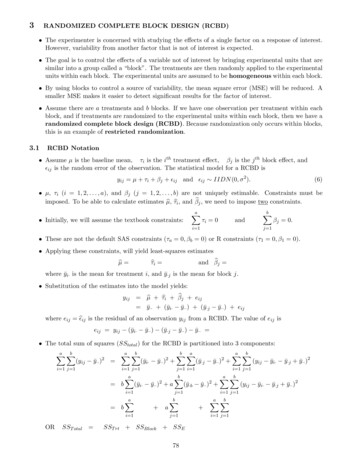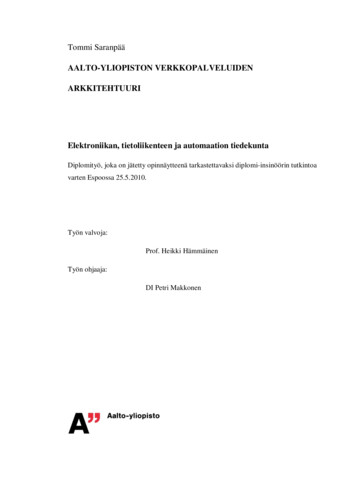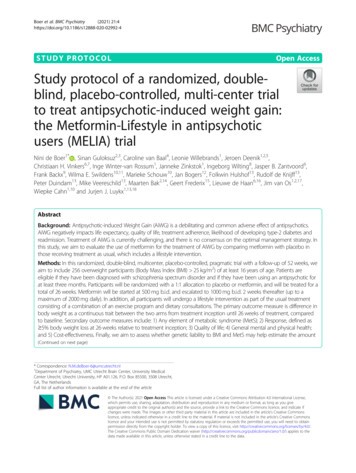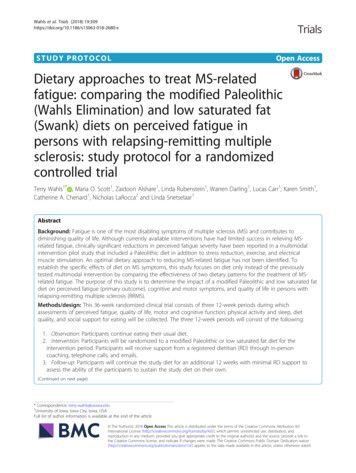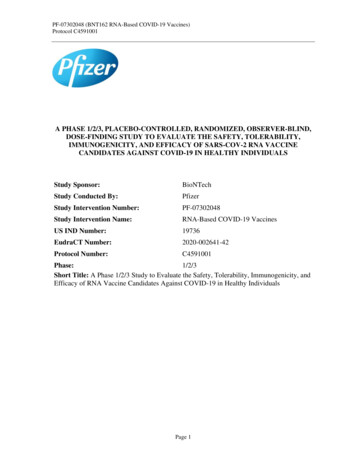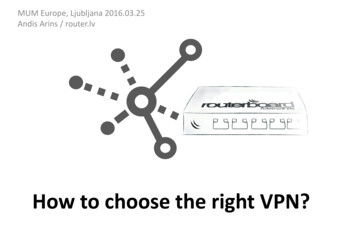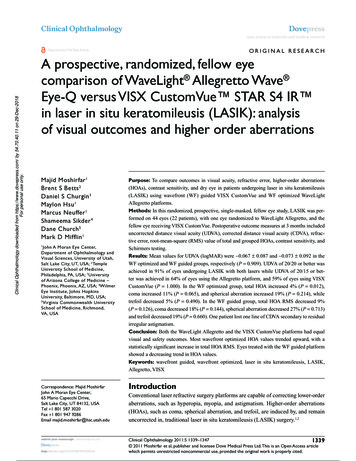
Transcription
Cameron et al. BMC Health Services Research 2014, TUDY PROTOCOLOpen AccessRandomized clinical trial of the timing it rightstroke family support program: research protocolJill I Cameron1,2*, Gary Naglie3,4,5, Monique A M Gignac6,7, Mark Bayley8,9, Grace Warner10, Theresa Green11,Anna Czerwonka1,2, Maria Huijbregts12,13, Frank L Silver14, Steve J Phillips15 and Angela M Cheung16,17AbstractBackground: Family caregivers provide invaluable support to stroke survivors during their recovery, rehabilitation,and community re-integration. Unfortunately, it is not standard clinical practice to prepare and support caregiversin this role and, as a result, many experience stress and poor health that can compromise stroke survivor recoveryand threaten the sustainability of keeping the stroke survivor at home. We developed the Timing it Right StrokeFamily Support Program (TIRSFSP) to guide the timing of delivering specific types of education and support to meetcaregivers’ evolving needs. The objective of this multi-site randomized controlled trial is to determine if delivering theTIRSFSP across the stroke care continuum improves caregivers’ sense of being supported and emotional well-being.Methods/design: Our multi-site single-blinded randomized controlled trial will recruit 300 family caregivers of strokesurvivors from urban and rural acute care hospitals. After completing a baseline assessment, participants will be randomlyallocated to one of three groups: 1) TIRSFSP guided by a stroke support person (health care professional with strokecare experience), delivered in-person during acute care and by telephone for approximately the first six to 12 monthspost-stroke, 2) caregiver self-directed TIRSFSP with an initial introduction to the program by a stroke support person, or 3)standard care receiving the educational resource “Let’s Talk about Stroke” prepared by the Heart and Stroke Foundation.Participants will complete three follow-up quantitative assessments 3, 6, and 12-months post-stroke. These includeassessments of depression, social support, psychological well-being, stroke knowledge, mastery (sense of control overlife), caregiving assistance provided, caregiving impact on everyday life, and indicators of stroke severity and disability.Qualitative methods will also be used to obtain information about caregivers’ experiences with the education andsupport received and the impact on caregivers’ perception of being supported and emotional well-being.Discussion: This research will determine if the TIRSFSP benefits family caregivers by improving their perception ofbeing supported and emotional well-being. If proven effective, it could be recommended as a model of stroke familyeducation and support that meets the Canadian Stroke Best Practice Guideline recommendation for providing timelyeducation and support to families through transitions.Trial registration: ClinicalTrials.gov: NCT00958607.Keywords: Stroke, Caregiver, Mixed methods, Randomized controlled trial, Social support, Education, LongitudinalBackgroundStroke is a complex medical condition and, as a result,stroke survivors utilize many elements of the health caresystem including acute, rehabilitation, and communitycare services. In Canada, an estimated 58% of strokesurvivors go directly home after acute care, 19% go to* Correspondence: jill.cameron@utoronto.ca1Department of Occupational Science and Occupational Therapy, Universityof Toronto, 160-500 University Ave, Toronto, Ontario M5G 1V7, Canada2UHN Toronto Rehabilitation Institute, Toronto, CanadaFull list of author information is available at the end of the articleinpatient rehabilitation before going home, and 10% areadmitted to long-term care [1]. As many as 50% ofstroke survivors returning to the community have difficulties performing every day activities, including bathing,walking short distances, negotiating stairs, housework,meal preparation and traveling [2]. Family caregivers assiststroke survivors with daily activities and navigating healthcare services [3]. Currently, there is no standard clinicalpractice to prepare family members for this caregiving role. 2014 Cameron et al.; licensee BioMed Central Ltd. This is an open access article distributed under the terms of the CreativeCommons Attribution License (http://creativecommons.org/licenses/by/2.0), which permits unrestricted use, distribution, andreproduction in any medium, provided the original work is properly cited.
Cameron et al. BMC Health Services Research 2014, s a result, caregivers often experience stress and poormental and physical health [4-6] that can contribute topoor rehabilitation outcomes for stroke survivors [7]or threaten the sustainability of care at home [8,9]. Atthe same time, health care delivery systems have beencriticized for reducing hospital lengths-of-stay [10], forlimiting availability of community services [11], and forlacking continuity across services [12]. This increases thedemand placed upon family caregivers as they supportindividuals with considerable disability across fragmentedsystems of care with very limited support from community resources. To date, programs have been developedto provide stroke-specific information and caregiver training and counseling, but these have had only a smallimpact on improving caregiver well-being [13]. Onepossible explanation, for this for which there is emerging evidence, is that these programs do not considercaregivers’ changing needs across the care continuum[14,15]. We developed the Timing it Right (TIR) framework that aims to guide the appropriate timing of specifictypes of education and support to meet the evolving needsof caregivers [16].“Timing it right” (TIR) frameworkThe “Timing it Right” (TIR) framework promotes an organized approach to developing and evaluating interventionsaimed at meeting family caregivers’ changing needs forsupport [16]. The TIR framework emphasizes familycaregivers’ unique support needs for each of five phases asdescribed in Figure 1. The event/diagnosis phase concernsthe time surrounding the stroke event and emergency care.This phase ends when the person’s medical condition hasstabilized, at which point caregivers enter the second phase,stabilization. The preparation phase occurs when the strokesurvivor is preparing for discharge home from inpatientacute or rehabilitation care. The implementation phaseconcerns the first few months after the stroke survivorreturns home and they are adjusting to living in thecommunity. The adaptation phase occurs once they arecomfortable living in the home environment and theiremphasis shifts to community re-integration.Figure 1 Timing it right framework (Cameron and Gignac, 2008).Page 2 of 9The premise of the framework is that careful attention tophase-specific needs for concrete information and strategieswill enhance family caregiver preparedness, ease theirtransitions across the care continuum, and decrease theoccurrence of negative outcomes [16] (e.g., burden, depressive symptoms, and other health issues). Ultimately,there will also be enhanced care of the person with stroke.Interventions developed according to the TIR frameworktarget the support provided to caregivers according totheir phase in the TIR framework.Existing caregiver interventions have drawn substantiallyfrom research on social support and aim to provide different elements of support including emotional (e.g., providingcomfort, listening to problems [17,18]), instrumental (e.g.,providing training in problem-solving [19,20]), informational(e.g., providing information about illness and services[18,21-23]), and appraisal support (e.g., providing feedbackabout their caregiving activities [24]). Therefore, we haveplaced the TIR framework in this context of social support.Previous research has demonstrated that family caregiverswho can draw upon social support will experience bettermental health outcomes [25-27]. In addition, support ismost beneficial if it is closely matched to an individual’scurrent needs [28]. This reinforces the need to more closelyexamine caregivers’ support needs over time and providesupport when and where they need it.Previous caregiver intervention researchTo date, some interventions have been developed topromote caregivers’ adaptation to their caregiving role(see reviews [13,29]). These interventions often provideinformation about the illness and treatment [18,21,22,30]or about community services [23]. Some provide caregivercounselling [17,18] or training to assist with solving caregiving problems [19,20,31]. In addition, others have proposedchanges to the delivery of acute care and inpatient rehabilitation (e.g., early supported discharge [32], integratedcare pathways [33]) that may also benefit family caregivers.Some investigators have studied caregiver interventionsthat cross a portion of the care continuum, most frequentlyfrom acute care to the home. These interventions typicallybegin when the patient is still in acute care and consist ofhome visits and/or telephone support to continue theintervention in the community [18,20]. Some interventions use trained nurses [20] or family support organizers[18] to deliver the intervention and have demonstratedsome benefit in caregiver outcomes (e.g., constant socialsupport). Similarly, telephone support provided by nurseeducators for family caregivers has been associated withsmall improvements in caregiver problem-solving skills,mental health, perception of preparedness, vitality, andsocial functioning [19,34,35]. Reviews suggest that theseinterventions result in small improvements in caregiverburden, emotional distress, psychological well-being, and
Cameron et al. BMC Health Services Research 2014, uality of life [29]. Larger improvements in outcomesare observed with interventions that are tailored to individual caregivers’ needs and are psychotherapeutic,psycho-educational, or multi-component in nature [29]. Todate, none of these interventions have specifically considered: 1) the appropriate timing of caregiver education andsupport; and 2) changes in caregivers’ needs as they providesupport to stroke survivors moving across the care continuum. Providing caregivers with the support they needwhen they need it may be of additional benefit.The appropriate model for intervention delivery acrossthe care continuum is not yet known. In our qualitativeresearch, caregivers indicated a need for one key individualto be available to them to answer questions and providesupport as needed while the stroke survivor was in thehospital and after they had returned home [15]. The strokesupport programs discussed above used trained nurses [20]or family support organizers [18] to deliver the interventionin person and by telephone [19,34,35]. Other models havefocused on providing integrated service delivery to enhancethe coordination of care as patients move across thecare continuum [12,36-38]. These commonly use a systemwhere one individual (e.g., a case manager [36]) organizesand facilitates a patient’s access to services across thehealth care system. The common thread of this researchsuggests we need to have one key individual providesupport across care environments.In addition, some recent research has highlighted thebenefits of preparing patients and their family membersto self-manage their transitions across care environments [39,40]. By providing family members with education and guidance, the self-management approachcan be extended to enable family members to self-directtheir learning and support needs across care environments. This second alternative for intervention deliverymay be a cost-effective way for caregivers to obtain theinformation, training and support that they require whenthey require it.Research objectives and hypothesesThe objective of this multi-site mixed methodology singleblind randomized controlled trial is to determine if theTIRSFSP delivered across the care continuum contributesto positive caregiver outcomes. Since this program targetsfamily caregiver support, the primary outcomes of theintervention will be caregivers’ perception of being supported in their caregiving role and improvements incaregiver mental health outcomes (e.g., less depression andmore psychological well-being). To determine the impactof the intervention on caregiver outcomes, we will comparetwo modes of intervention delivery with standard care: 1)repeated contact in person and by telephone with a strokesupport person (health care professional with stroke careexperience, intervention arm 1); and 2) a self-directedPage 3 of 9program by the caregiver (intervention arm 2). Thespecific research hypotheses are the following:Hypotheses1. Family caregivers receiving the TIRSFSP delivered bya stroke support person and the self-directedTIRSFSP will report more perceived support andbetter mental health than the standard care group.2. Family caregivers receiving the TIRSFSP delivered bya stroke support person will report more perceivedsupport and better mental health compared to thosereceiving the self-directed TIRSFSP and standard care.MethodsTrial designWe will conduct a convergent parallel mixed methodology[41], longitudinal, multi-site, single-blind randomized controlled trial. As a convergent parallel mixed methodologydesign, the quantitative and qualitative portions of the studywill provide different but complementary perspectives oncaregivers’ experiences with support received [41]. Recruitment will take place in 7 acute care hospitals from acrossCanada. Caregivers will be recruited during the patients’acute care hospital admission. They will complete baselineassessments prior to randomization and follow-up assessments at 3, 6, and 12-month’s post stroke. All caregiverswill provide written informed consent. The researchprotocol has been approved by institutional research ethicsboards at all participating hospitals, including the following:University Health Network Research Ethics Board, CapitalHealth Research Ethics Board, Ottawa Hospital ResearchEthics Board, University of Toronto Office of ResearchEthics, University of Calgary Faculty of Medicine Office ofMedical Bioethics Conjoint Health Research Ethics Board,Pembroke Regional Hospital Research Ethics Committee,Thunder Bay Regional Health Sciences Centre ResearchEthics Board, Lakeridge Health Research Ethics Board,Queen’s University Health Sciences & Affiliated TeachingHospitals Research Ethics Board, Health PEI ResearchEthics Board, Royal Victoria Hospital Research EthicsBoard, and Cape Breton District Health Authority ResearchEthics Board.ParticipantsFamily caregivers are defined as the person primarilyresponsible for providing and/or coordinating strokesurvivor care in the community without financial compensation. If during acute care there appears to be more thanone family caregiver, we will invite the family memberwho, in discussion with the family, is likely to be primarilyresponsible for providing and/or coordinating care in thehome.
Cameron et al. BMC Health Services Research 2014, nclusion criteriaParticipants will be included if they are able to read andspeak English and will be caring for a person who is eitherreceiving care for their first hospitalization for an ischemicor hemorrhagic stroke or whose previous stroke was mildand they did not require admission to inpatient or outpatient rehabilitation care. The stroke survivor’s anticipated ultimate destination after discharge is a privateresidence or apartment building. Stroke survivors mustexhibit at least minimal disability (i.e., referred to an occupational therapist, physical therapist, or speech languagepathologist during acute care). Stroke survivors may beadmitted to short or long-duration inpatient (maximumduration of 6 months) or outpatient rehabilitation or returndirectly home. During inpatient rehabilitation, there will bestroke survivors who do not reach their rehabilitation goalsand will, therefore, not be able to return home. When thisoccurs, we will exclude their caregivers from the study.Exclusion criteriaWe will exclude caregivers of patients who are terminallyill, discharged to alternative levels of care, or discharged tolong-term care or assisted retirement residences.InterventionsParticipants in intervention arms 1 and 2 will receive theTIRSFSP Guide. This educational resource contains anintroductory chapter, one chapter for each phase in theTIR framework, and a concluding chapter containing listsof local resources available to the patient and caregiver(see Table 1). The content of each chapter is based on theTIR framework [16] and caregivers descriptions of theirphase-specific experiences and needs obtained during aprevious qualitative study [15]. We leveraged existingeducational and support resources, created new resources,and organized them according to the phases of the TIRframework. Each chapter provides emotional support bydescribing how some caregivers may feel emotionallyduring each phase [15]. Each chapter also provides a“who to talk to for help” section to guide caregivers as towho they should speak with for certain areas of concernTable 1 Contents of the timing it right stroke familysupport program guideChapterTitle1.Introduction to the program2.My family member has had a stroke3.My family member’s condition has stabilized4.My family member is preparing to go home5.My family member has just returned home6.Adapting to life in the community7.Additional resourcesPage 4 of 9(e.g., speech language pathologist to learn more aboutcommunicating with a stroke survivor with aphasia).The introduction to the guide instructs caregivers to“self-manage” their support needs [42,43]. It providescaregivers with strategies for eliciting help and supportfrom family and friends, communicating effectively withhealth care professionals, obtaining community services,and succeeding at caregiving. Caregivers will be instructedto review the information in each chapter as it becomesrelevant to their current situation (i.e., as they movethrough the TIR phases). Caregivers can review the guideas often as they like.1. Stroke Support Person TIRSFSP: The interventionwill be delivered by a stroke support personin-person during the acute care phase and then bymonthly telephone calls for approximately six monthsafter the stroke survivor is discharge home. The strokesupport person is a health care professional involvedin the coordination of stroke services and provision ofeducation and support (e.g., occupational therapist,social worker, nurse educator, case manager). Duringeach session, the stroke support person will askcaregivers how things have been going, how they aredoing, and what their needs are so they can guidethem through appropriate sections of the TIRSFSPeducational resource and help them obtain thesupports they currently need. The stroke supportperson will encourage, using self-managementprinciples, caregivers to obtain the needed supportsfrom the appropriate health care professional(e.g., training in caregiving activities from anoccupational therapist) or appropriate communityresources. They will give the caregivers a copy of theTIRSFSP guide as a resource. The support person willencourage the caregiver to contact them betweenregular appointments if they have any specificquestions. Our pilot study indicated that the firstmeeting is the longest and takes approximately 60minutes and subsequent meetings are 10–30 minuteseach [44]. The intervention content and duration,including time spent during each session andnumber of sessions, is tailored to individualcaregivers’ experiences and needs.2. Self-Directed TIRSFSP: In the second arm of thistrial, family caregivers will self-direct their use of theTIRSFSP guide. The stroke support person will meetwith the caregiver once during the acute strokephase to instruct them on the use of the guide. Theywill provide an overview of the self-managementprinciples and encourage them to manage theirsupport needs.3. Standard Care: Current standard care in the strokecentres of the Ontario Stroke System is for stroke
Cameron et al. BMC Health Services Research 2014, urvivors and/or family members to receive a copyof the Heart and Stroke Foundation’s “Let’s Talkabout Stroke” educational resource. This resourceprovides general information that is not specific tophase of recovery, to educate stroke families aboutwhat a stroke is, treatment options, secondaryprevention, and impact on stroke survivors’ healthand well-being. The research assistant will ensurethat all caregivers recruited into the trial receive a copyof “Let’s Talk about Stroke” with a brief introductionto its contents.Data collectionThree sources of data will be collected in the form ofstructured quantitative measurement instruments, qualitative interviews, and stroke support person journals.Structured Quantitative Measurement Instruments:Caregiver outcomes are the focus of this study. Theresearch assistant in each region will obtain the baselineand follow-up data at 3, 6, and 12-months post-stroke.All measurement instruments have been used previouslyin stroke caregiving research and demonstrate good psychometric properties [45-47]. In the pilot study, administration of these quantitative measures took approximately30–45 minutes [44]. All data will be entered into the EmPower web-based system that will support and managethe data this clinical trial [48]. Caregivers will be able tocomplete mailed surveys or enter their responses directlyinto EmPower.The primary outcome, caregiver’s perceived socialsupport, will be assessed by the Medical Outcomes StudySocial Support Scale [49]. Positive and negative mentalhealth outcomes, will be assessed by the Positive AffectScale [50] and the Centre for Epidemiological StudiesDepression Scale [51], respectively. Caregivers’ participationin valued activities, will be assessed by the CaregivingImpact Scale [45,52]. The level of assistance provided tothe stroke survivor in terms of activities of daily living,instrumental activities and medical care will be assessedby the Caregiving Assistance Scale [45,52]. Caregivers’stroke knowledge concerning warning signs, causes, consequences, treatment options, rehabilitation, and secondaryprevention will be assessed by the Stroke Knowledge Test[53]. Caregivers’ sense of control over life will be assessedby Pearlin’s Mastery Scale [54]. Personal developmentas a result of providing care will be assessed by Pearlin’sPersonal Gain Scale [55]. To facilitate an economic analysisrelated to the intervention, we will also collect HealthResource Utilization data (adapted from Brown, 1990 [56].Sociodemographic characteristics of the caregiver will alsobe assessed. Stroke patients’ charts will be reviewed to obtain the following information: stroke severity (CanadianNeurological Scale [57] completed during the first week ofhospital admission), functional status as measured by thePage 5 of 9Barthel Index [58], stroke type and location, and dateof stroke.Qualitative interviewsA sub-sample of 36 (12 per intervention arm) caregiverswill participate in a qualitative interview after the completion of the final follow-up assessment. Research assistantswith training in qualitative interviewing will conduct all theinterviews by telephone. Telephone interviews have beenshown to provide qualitative data of the same quality andquantity as in-person interviews [59]. We will use framework methodology to describe caregivers’ experiences andneeds during each phase of the TIR framework and howthe intervention arm that they received did or did notmeet their needs [60,61]. Based upon our pilot study, weestimate the qualitative interviews will take approximately45–60 minutes [44].Stroke support person journalsFor each site, the stroke support person will complete ajournal to record the details of the intervention providedto participants. Specifically, for each contact with eachcaregiver, they will record the duration of the contact,topics discussed, and resources provided. This informationwill help us to understand more fully the role that thestroke support person fills and the time commitment tofill this role.Sample sizeThe target sample size is 300 family caregivers (seeFigure 2). With a sample of 100 participants per group wewill be able to observe a medium sized difference betweenthree treatment groups in our primary outcome, caregiver’sperceived social support (Social Support Survey, mean 73.3,SD 20.8) (80% power, P .05 significance) [62]. The estimated sample size remained the same when calculatedusing the Center for Epidemiological Studies - DepressionScore and the Positive Affect Scale as outcome measures(described above). Our sample will include caregiversfrom urban (n 240) and rural (n 60) environments tobe representative of the Canadian population (approximately 80% urban and 20% rural). We are using StatisticsCanada’s rural definition “A community (generally a municipality in the west and a township in the east) is definedas “rural” if its population density is less than 150 peopleper square kilometer”.A sub-set of 36 family caregivers will participate in thequalitative portion of the study. Based on our previousqualitative study with stroke family caregivers, we areconfident that this number will ensure saturation of research themes [15,63]. Caregivers will be purposively sampled to reflect the intervention groups (i.e., 12 participantsper research group) [64].
Cameron et al. BMC Health Services Research 2014, age 6 of 9Figure 2 Anticipated CONSORT diagram including follow-up protocol and qualitative data collection.RandomizationResearch assistants responsible for recruiting participantsinto the study will enter baseline data into EmPower andEmPower will use a random number generator to placeparticipants into one of the 3 treatment arms: A) TIRSFSPdelivered by a stroke support person, B) TIRSFSP selfdirected by the caregiver, and C) standard care. EmPowerwill email the stroke support person to inform them whena participant has been randomized. We will use stratifiedrandomization to ensure an equal distribution of participants across intervention arms within each site.BlindingThe research assistant who collects the baseline andfollow-up data will be blind to group assignment.Statistical methodsAnalysis of quantitative dataWe will analyze the data on the principle of intention totreat. Hierarchical linear modeling for longitudinal datawill examine changes in caregiver outcomes over thefollow-up period and examine differences between studygroups for each outcome [65]. We will use mixed effectsmodeling as it accounts for the underlying heterogeneitybetween and within participants (i.e., intercepts and slopesare allowed to vary across participants). This approach willalso allow us to identify differences in rates of change(slopes) in the dependent variables between study groups(e.g., participants in the intervention group with a supportperson may have earlier improvements in stroke-relatedknowledge). It will also allow us to control for confoundingvariables that can also influence caregiver outcomes(e.g., stroke severity). Because intercepts and slopes arecomputed for each participant, caregivers who miss afollow-up assessment or drop out of the study are stillincluded in the data analyses.Analysis of qualitative dataThe in-depth qualitative interviews will be analyzed usingthe 5 stages of framework analysis: 1) familiarizing bylistening to the interviews and reviewing the transcripts;2) selecting a thematic framework (e.g. TIR model); 3)
Cameron et al. BMC Health Services Research 2014, ndexing or coding the data according to the framework; 4)charting the data on the framework, and 5) interpretation[60,61]. This approach will allow examination of caregivers’changing experiences and needs across the recovery trajectory and determine the extent to which their arm of theintervention met their needs. With this number of qualitative interviews (e.g., 12 participants per intervention arm)we will be able to compare and contrast caregivers’ experiences and needs across intervention arms. Researcher biasis a common threat to the trustworthiness of qualitativedata analysis. To minimize this threat we will use thefollowing strategies as recommended by McReynolds[64]: 1) we will maintain an audit trail by keeping recordof all data, analysis procedures, and analysis notes; 2)multiple researchers will contribute to the data analysisand theme generation; and 3) we will carefully examinediscrepant data (i.e., data that does not support the researchers preliminary conclusions) [64]. We will use NVivo10 qualitative software to organize the coding process [66].Analysis of stroke support persons’ journalsThe stroke support persons’ journals for each phase willbe reviewed to determine: 1) the amount of time the strokesupport person spends with each caregiver, 2) the topicsdiscussed, and 3) the resources provided. This informationwill be summarized for each site’s stroke support personand then averaged across sites. The topics and resourcesprovided will be synthesized using conventional contentanalysis [67,68]. Specifically, for each phase of the intervention, we will count the number of times each topic isdiscussed and each resource is provided to identify the keytopics and resources for each phase of the intervention.Combining findings across different methodologiesEach of these analyses will help us to understand if theintervention improves caregiver outcomes (quantitativeanalysis), how it does this (qualitative analysis), and how itis delivered (stroke support person journal). This information can be us
to self-manage their transitions across care environ-ments [39,40]. By providing family members with edu-cation and guidance, the self-management approach can be extended to enable family members to self-direct their learning and support needs across care environ-ments. This second alternative for intervention delivery

